[Updated 6 November, 2025]
In this era where hybrid work, global teams, and rapid adjustments in the face of change are the norm, the significance of collaboration technologies cannot be overstated. They bridge geographical gaps, ignite creativity through virtual brainstorming, and empower real-time decision-making. In fact, according to research, 83% of employees rely on technology for collaboration.
Collaboration technology reshapes business operations and fundamentally alters how we connect, learn, and innovate at work. So, as we explore the exciting world of collaboration technologies, we invite you to uncover the potential they hold for individuals, organizations, and the future of work itself.
TL;DR:
- Collaboration technologies are vital in the era of hybrid work and global teams.
- They enable real-time decision-making and bridge geographical gaps.
- 83% of employees rely on technology for collaboration.
- There are two types: synchronous (e.g., Zoom) and asynchronous (e.g., email).
- They serve functions like communication, learning, and project management.
- Collaboration tech enhances productivity, attracts talent, and streamlines operations.
- Concerns include security risks and potential miscommunication.
- Trends include AI integration, cloud-powered tools, and immersive experiences.
- Choosing the right tech involves identifying needs, understanding team needs, and budget considerations.
- Collaboration technologies are shaping the future of work as catalysts for a new era of collaboration.
What is Collaboration Technology?
Collaboration technology refers to the set of digital tools and platforms designed to enhance coordination and cooperation within an organization. They strengthen communication, bring people closer even if they're far away, break down barriers between hybrid teams, allow instant interaction, and help everyone understand and work on projects together. Ultimately, technologies for collaboration create a virtual workspace that seamlessly connects team members irrespective of their geographical locations or time zones.
Collaborative tech is all about making teamwork smoother and more engaging. Instead of boring whiteboard talks, it can turn them into exciting multimedia presentations, improving the quality of professional interactions. So, forget that "teamwork makes the dream work." It's sophisticated collaboration technology that does the trick!
Now, let's move on to the next question: what kinds of tools fall under this category?

The Two Types of Collaboration Technologies
To understand collaboration technologies, it's essential to know about two types of communication: synchronous and asynchronous. Let's dig deeper into these.
Technologies for Synchronous Collaboration
Effective teamwork relies on real-time interaction, and this is where synchronous collaborative technologies play a crucial role. Examples of such technologies include Zoom and Microsoft Teams for video calls and Slack or WhatsApp for instant messaging.
In these settings, conversations unfold in the moment, allowing for immediate responses, which is particularly valuable for brainstorming sessions or urgent discussions. Team members can contribute promptly and actively engage as meetings progress in real time.
One remarkable feature of synchronous collaboration technologies is their ability to eliminate geographical barriers, enabling colleagues from different locations to participate equally in virtual meetings. This rapid and fluid exchange of ideas enhances decision-making efficiency, making these technologies especially popular in fast-paced business environments.
However, synchronous collaboration technology may not suit all work scenarios. This is where asynchronous collaboration tech comes into play.
Technologies for Asynchronous Collaboration
Asynchronous collaboration technology, on the other hand, caters to a different aspect of effective teamwork. It recognizes that not all work can happen in real time and provides valuable solutions for scenarios where immediate interaction isn't essential. Tools like email, project management platforms such as Trello and Productive, or shared document systems like Google Docs exemplify asynchronous collaboration tech.
YAROOMS can also be considered an asynchronous collaboration tool because it enables users to coordinate and manage shared spaces, meeting rooms, and resources efficiently, allowing for planning and scheduling without the need for immediate real-time interaction.
In asynchronous settings, discussions and contributions don't require instant responses. This flexibility is beneficial for tasks that demand thorough research, careful consideration, or accommodate varying time zones and schedules. It allows team members to contribute when convenient, fostering a more inclusive and accommodating work environment.
One of the standout features of asynchronous collaboration technology is its adaptability to diverse work situations. It complements real-time communication by providing an avenue for thoughtful reflection and well-structured contributions. This versatility makes asynchronous collaboration tech indispensable for organizations striving to balance productivity with flexibility in today's dynamic work landscape.
| Aspect | Synchronous Collaboration Tech | Asynchronous Collaboration Tech |
|---|---|---|
| Definition | Real-time communication tools that enable immediate interaction and feedback. | Communication and coordination tools that allow delayed responses and flexible participation. |
| Examples | Zoom, Microsoft Teams, Slack, WhatsApp | Email, Trello, Productive, Google Docs, YAROOMS |
| Interaction Style | Conversations happen live; responses are instant. | Communication occurs over time; participants reply when convenient. |
| Best For | Brainstorming sessions, quick decision-making, urgent discussions. | Tasks requiring deep work, research, documentation, or accommodating different time zones. |
| Key Benefit | Encourages active engagement and immediate collaboration across locations. | Promotes flexibility, thoughtful input, and inclusivity across diverse schedules. |
| Main Limitation | Can be disruptive and dependent on availability; less suited for reflective work. | Slower communication flow; potential delays in decisions or feedback loops. |
| Typical Use Cases | Daily stand-ups, real-time project updates, crisis response. | Project planning, knowledge sharing, content reviews, hybrid scheduling, and workplace coordination. |
| How It Enhances Teamwork | Breaks down geographical barriers and boosts engagement in fast-paced environments. | Complements real-time tools by supporting structured, well-considered contributions. |
Comparison: synchronous vs. asynchronous collaboration technologies
Key Functions of Workplace Collaboration Technology
One can't help but admire how collaboration technologies, with their wide range of capabilities, have reshaped today's digital work environment. They serve not merely as utilities for interaction but as multi-dimensional platforms facilitating different tasks and operations.
Communication and Coordination
A fundamental function of collaboration technology is to facilitate team communication. It acts like a virtual conference room where teams communicate in real-time. Such technologies enable instant messaging, video conferencing, and file sharing - connecting employees at the click of a button.
Moreover, these collaborative tech solutions are essential in coordinating teams. They offer features that allow scheduling meetings, setting reminders, tracking availability, and managing deadlines—all centralized on one platform, improving efficiency through streamlined coordination.
Learning and Growth Programs
In addition to its leading role in communication and scheduling, collaboration technology presents potent tools for learning and growth initiatives within businesses. Traditional barriers preventing an effective learning environment—such as timezone differences or physical distances—are efficiently mitigated using these technologies.
For instance, teleconferencing provides live interactive training, while asynchronous collaboration tools enable self-paced learning programs available round-the-clock. Collaborative technologies also provide a repository for various educational materials ranging from text documents to multimedia files, further enhancing this learning experience.
Streamlined Project Management
Undoubtedly, one of the crucial aspects of running a successful project is keeping track of progress while ensuring timely delivery; this is another area where collaborative technology shines bright. Collaborative tools offer easy-to-use interfaces that visualize information about task assignments, due dates, project stages, and more.
Besides updating statuses or providing feedback about individual tasks, these solutions create transparency around workload distribution, helping managers make informed decisions related to resource allocation.
Workspace Booking
Workspace booking is a fundamental function of collaborative technology, streamlining the management of shared workspaces, meeting rooms, and resources within organizations. This feature allows employees to conveniently reserve workspaces, whether a meeting room, a desk, or a specialized facility, through user-friendly interfaces or mobile apps. It minimizes the time-consuming process of manually scheduling and coordinating space usage, preventing conflicts, and optimizing workspace utilization.
By centralizing workspace booking into one collaborative platform, organizations can efficiently allocate resources and ensure that employees have the spaces they need when they need them. Additionally, it facilitates flexibility in the modern workplace, accommodating remote work arrangements and hot-desking environments.
Press on the media above for a self-guided demo of YAROOMS workspace booking
Flexible Scheduling
Flexible scheduling refers to the capability of collaboration technologies to support and facilitate adaptable and dynamic hybrid work schedules.
When facilitated by collaboration technologies, flexible scheduling offers employees greater control over their work hours and locations, supports work-life balance, and enhances overall productivity and job satisfaction. It empowers organizations to adapt to diverse scheduling needs and can contribute to a more agile and efficient workforce.

Benefits of Using Collaboration Technologies
Collaboration technologies offer many significant benefits that can greatly improve how an organization works. Let's explore these advantages in more detail.
Improved Employee Productivity
Collaboration technologies significantly boost employee productivity by streamlining communication, making it easier for team members to share ideas, updates, and feedback promptly. Employees can work more efficiently and make quicker decisions with better access to information and resources. Collaborative technology also enables hybrid work and flexible schedules, allowing employees to maintain productivity even when not in the office. All of these factors contribute to a more productive workforce.
Increased Accessibility of Resources
Collaboration technologies facilitate easy access to shared documents, data, and information, ensuring that team members can retrieve what they need quickly and conveniently. This accessibility extends to remote or dispersed teams, enabling everyone to tap into essential resources regardless of location. As a result, organizations can harness the full potential of their collective knowledge and assets, fostering greater efficiency in their operations.
Attracting and Retaining Talent
Success has a magnetism factor. As businesses increasingly implement digital technologies for communication in their operations, they demonstrate growth and innovation potential. These signals attract top talent looking for great digital employee experience. Moreover, practical applications like collaborative tech solutions provide ease-of-work aspects to employees, thus making them more likely to stay on board.
Streamlined Onboarding
Digital collaborative technologies simplify the process of onboarding new hires. By granting fresh recruits access to adequate platforms filled with job-specific documents, guidelines, or FAQs during their initiation period, organizations ensure smooth entry and reduce the time usually wasted hunting for relevant information.
Better Brainstorming
Collaboration technologies provide virtual spaces where team members can contribute ideas in real-time or asynchronously, accommodating various thinking styles and schedules. Additionally, features like chat, file sharing, and interactive whiteboards enhance the brainstorming process, allowing for more creative and structured discussions. This way, brainstorming becomes a dynamic and inclusive activity, leading to better ideas and innovative solutions.
Enhanced Workplace Visibility
Enhanced workplace visibility is another notable advantage of collaboration technologies. These tools offer transparency by providing real-time updates, progress tracking, and shared project timelines. Team members can easily see who is working on what (and where) and monitor the status of tasks and projects or schedule teamwork. This increased visibility into the workplace allows organizations to allocate resources better, identify bottlenecks, and ensure everyone is on the same page, ultimately improving efficiency and the overall functioning of the team or organization.
Better Teamwork and Open Communication
Collaboration technologies foster better teamwork and open communication within organizations. These tools create a seamless environment for team members to collaborate, share ideas, and provide feedback. They promote transparency, trust, and a sense of inclusion by breaking down communication barriers. Team members can engage in real-time discussions, share documents, and collaborate on projects easily, leading to improved teamwork, where everyone's contributions are valued and communication flows more freely.
Concerns When Using Collaboration Technology in the Workplace
As beneficial as collaboration technologies can be, we should not overlook potential drawbacks. These concerns stem mainly from two areas: security issues and the likelihood of… miscommunication.
Security Concerns
Cybersecurity becomes crucial when using any form of digital tools, particularly collaborative technology. Confidential and sensitive information shared on these platforms is potentially vulnerable to cyber-attacks. Consider this:
- Cyber threats are continually evolving, with advanced strategies being devised by hackers.
- Data breaches may lead to business losses and damage your reputation and trust among partners and clients.
- Unauthorized access might lead to misuse or theft of vital business data.
- Potential loss of control over critical information as collaborative tech solutions often store data in cloud-based systems.
Despite these risks, don’t let fear deter you from harnessing the power of technologies for collaboration. Keeping up-to-date with updated security protocols and fostering a cybersecurity culture at work can help mitigate these issues significantly.
Potential for Miscommunication
The second area needing attention when adopting collaborative technology involves communication challenges. Although it's designed to facilitate clear interactions, misinterpretation remains a constant threat. Consider this:
- Without face-to-face interactions, nuances like tone or body language can evoke misunderstandings.
- Collaborative tech, especially asynchronous communication tools, can leave room for messy or unstructured discussions.
- As teams grow more diverse because of hybrid work, some messages may get lost in translation despite various collaboration technologies.
Implementing regular training sessions showing what collaborative technology is and how it functions, along with promoting collaborative culture, will bridge communication gaps effectively.
Awareness of the concerns connected with collaboration technology allows a strategic approach towards addressing them head-on. It's all about striking that balance!

Trends in Collaborative Technology
Collaboration technology is rapidly evolving. With constant technological advancements, emerging new trends promise to reshape the way we collaborate and communicate within and beyond organizational boundaries:
- Evolving work environments: Many organizations are embracing hybrid work models, fueling the demand for tools that effortlessly facilitate collaboration in person or remotely.
- AI Integration: Collaboration tools incorporate artificial intelligence (AI) and automation for tasks such as chatbots, predictive analytics, and document management, augmenting productivity.
- Cloud-powered collaboration: The ongoing ascent of cloud-based collaboration tools enables effortless access and data sharing from anywhere, promoting flexibility.
- Enhanced security measures: Growing apprehensions about data security and privacy are prompting the development of robust security features within collaboration platforms, ensuring data protection.
- Immersive experiences: Virtual Reality (VR) and Augmented Reality (AR) are being explored to create immersive remote collaboration experiences, particularly in domains like design, education, and healthcare.
- Customization and integration: Collaboration platforms are becoming more versatile with open APIs and customization options tailored to meet specific business requirements.
- Seamless cross-platform functionality: Collaboration tools are placing a premium on compatibility with diverse devices and operating systems, guaranteeing seamless communication across various platforms.
- Data-driven insights: Leveraging workplace data analytics to derive valuable insights into collaboration patterns, employee productivity, and workflow optimization is becoming increasingly prevalent.
- Sustainability in focus: Collaboration tools are now designed to advocate for remote work and reduce the carbon footprint associated with physical meetings and travel.
Collaboration Technology Statistics You Should Know in 2026
- The global collaboration software market is projected to surpass $30 billion by 2026, driven by increasing demand for effective communication and information exchange within organizations, especially large enterprises managing outsourcing and remote work.
- The social collaboration software market was valued at $11.34 billion in 2025 and is expected to grow at a compound annual growth rate (CAGR) of 11.27% from 2026 to 2033.
- Enterprise collaboration software adoption has increased by 300% since 2020, with key features driving usage being unified messaging, video conferencing, real-time document co-editing, AI-enhanced workflows, and task/project management.
- By 2026, around 80% of employees are expected to consume insights directly within their daily business applications like CRM, enhancing data-driven collaboration.
- About 90% of employees say that intuitive and effective collaboration technology positively impacts their job satisfaction, emphasizing the importance of user-friendly digital workplace tools.
- AI-powered collaboration tools improve team productivity by an estimated 20-30%, yet only about 30% of employees receive formal training on these technologies, indicating potential for improved adoption and ROI.
- Enterprises using collaboration software report up to a 25% reduction in project completion times and a 17% increase in employee engagement scores, directly linked to improved communication and transparency.
- Employee engagement platforms tightly integrated with collaboration tools increase employee participation rates by 15-20%, showing measurable uplift in motivation and retention.
- The rise of AI assistants in collaboration apps automates routine tasks, saving employees on average 2-3 hours per week, contributing to workload reduction and increased focus on strategic work, although training gaps remain a challenge.
Examples of Workplace Collaboration Technologies
In this section, we will share some examples of major collaborative technologies that are shaping the way organizations work and collaborate in today's digital age. From video conferencing platforms to space booking tools, these technologies play a pivotal role in enhancing productivity and fostering seamless teamwork.
Video Conferencing Solutions
In our globalized world, where teams often sit across continents and time zones, video conferencing has become a prime player in collaborative tech solutions. The benefits are enormous.
For one, it adds a human element to business communication by making virtual meetings almost as engaging as face-to-face ones. It reduces travel costs and saves time but still enables direct communication through body language and facial expressions.
Microsoft Teams
Microsoft Teams is an all-in-one video conferencing and collaboration platform within Microsoft 365. It connects meetings, chat, file sharing, and scheduling under one interface.
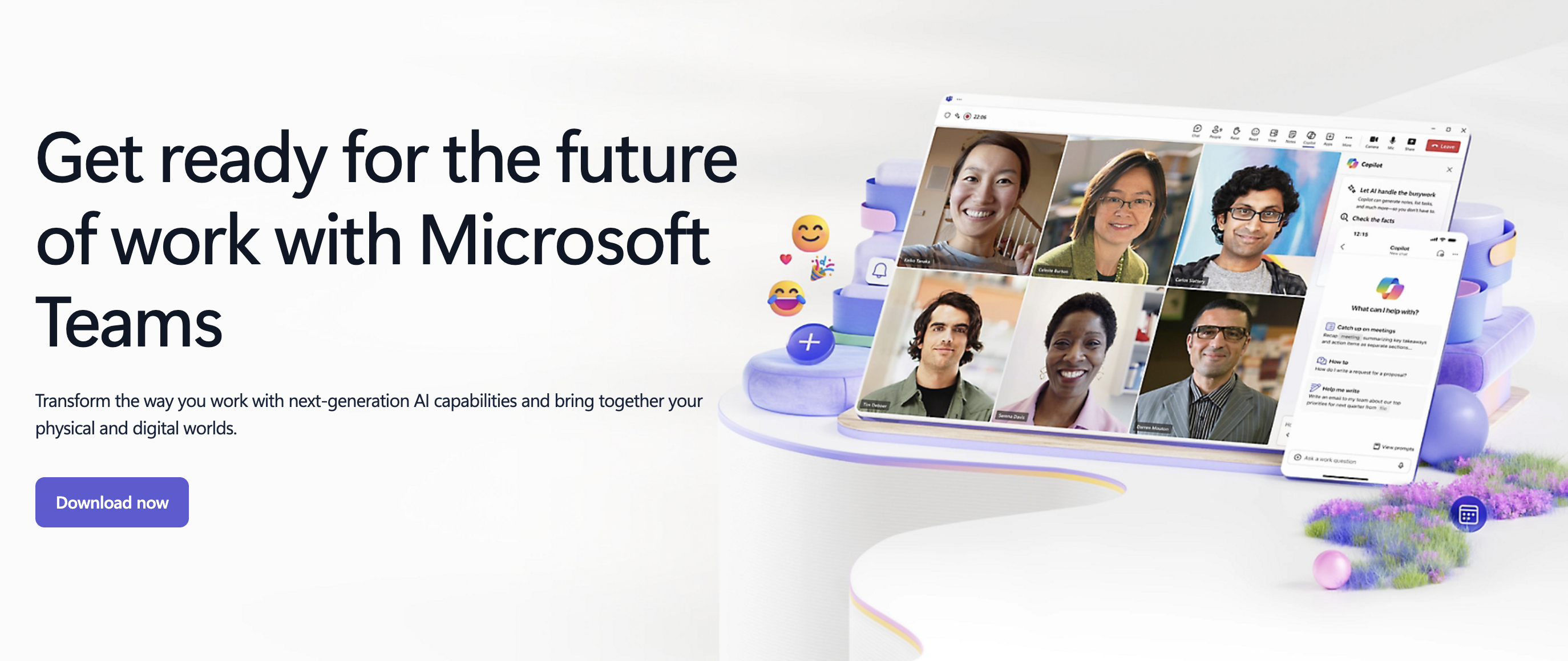
Best for: Organizations using Microsoft 365.
Use cases: Hybrid meetings, webinars, project collaboration, enterprise communication.
Key features:
-
Real-time co-editing in Word, Excel, and PowerPoint
-
Meeting recordings, transcripts, and captions
-
Enterprise-grade security and compliance
Microsoft Teams unifies video, documents, and chat, reducing tool fragmentation and improving coordination.
Zoom
Zoom is a scalable video conferencing platform known for reliability and ease of use. It supports 1-on-1 calls to enterprise-level webinars.
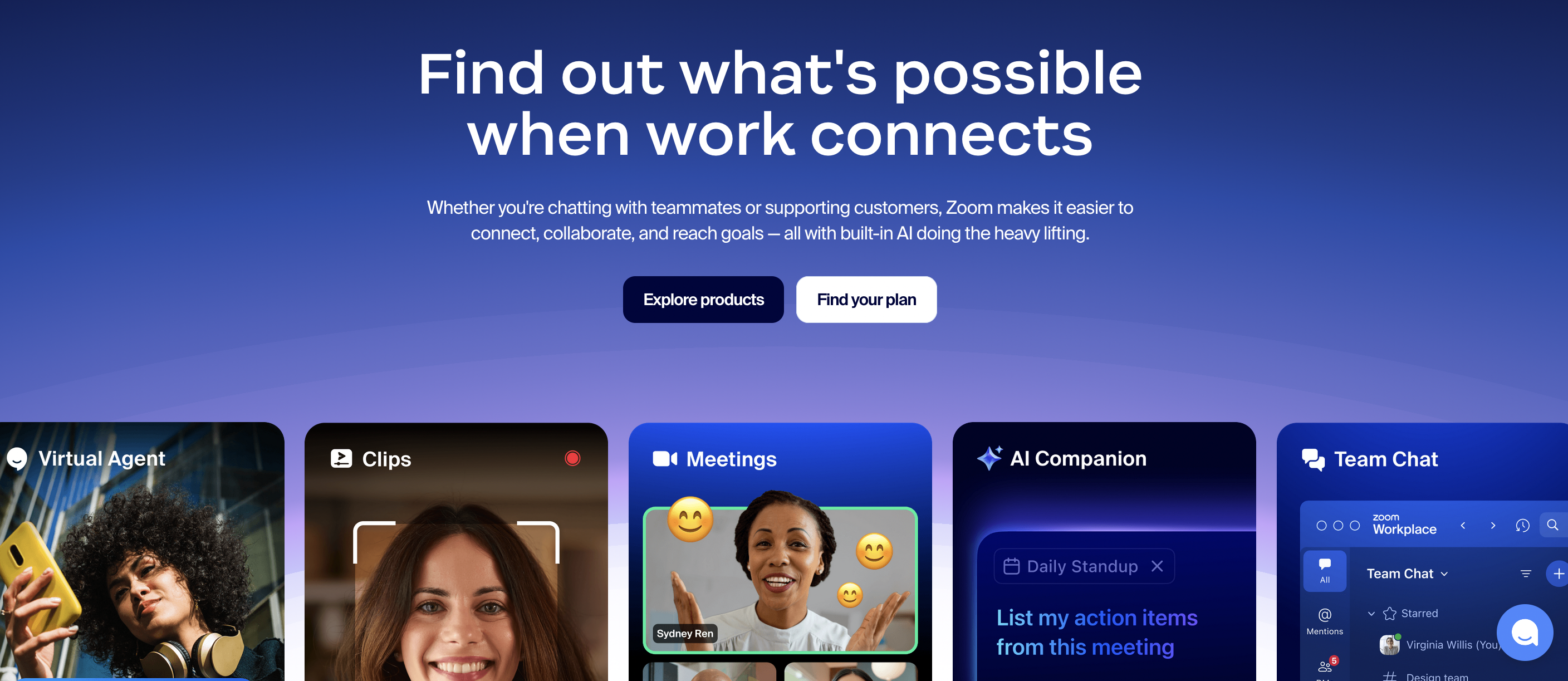
Best for: Organizations of all sizes that value simplicity and stability.
Use cases: Virtual meetings, training sessions, webinars, client presentations.
Key features:
-
HD video and breakout rooms
-
Automated captions and AI meeting summaries
-
Whiteboard and app marketplace
Zoom remains the go-to solution for dependable virtual communication in hybrid workplaces.
Google Meet
Google Meet is a browser-based video meeting tool integrated into Google Workspace. No installations or plugins required.
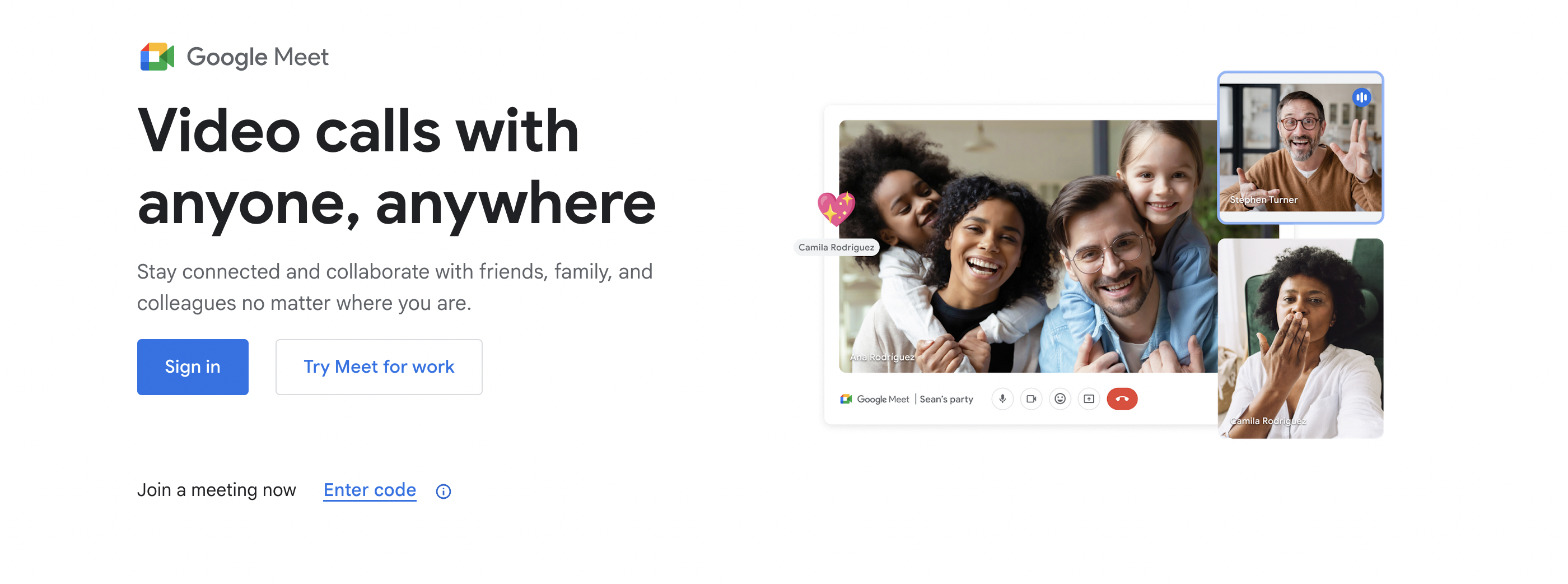
Best for: Teams that collaborate daily in Gmail, Calendar, and Drive.
Use cases: Remote team check-ins, education, nonprofits, cross-regional meetings.
Key features:
-
Automatic link creation in Google Calendar invites
-
AI-powered noise cancellation and live captions
-
Simple interface, ideal for quick connections
Perfect for distributed teams that prioritize speed and accessibility over heavy features.
Cisco Webex
Cisco Webex is an enterprise-grade video conferencing and collaboration suite emphasizing security and scalability.

Best for: Regulated industries (finance, healthcare, government).
Use cases: Confidential meetings, multi-location teams, corporate events.
Key features:
-
End-to-end encryption
-
Real-time analytics and participant engagement tools
-
Hardware ecosystem for hybrid rooms
Trusted by enterprises where compliance and reliability are non-negotiable.
Slack Huddles
Slack Huddles offers quick audio and video calls directly inside Slack — ideal for spontaneous collaboration.
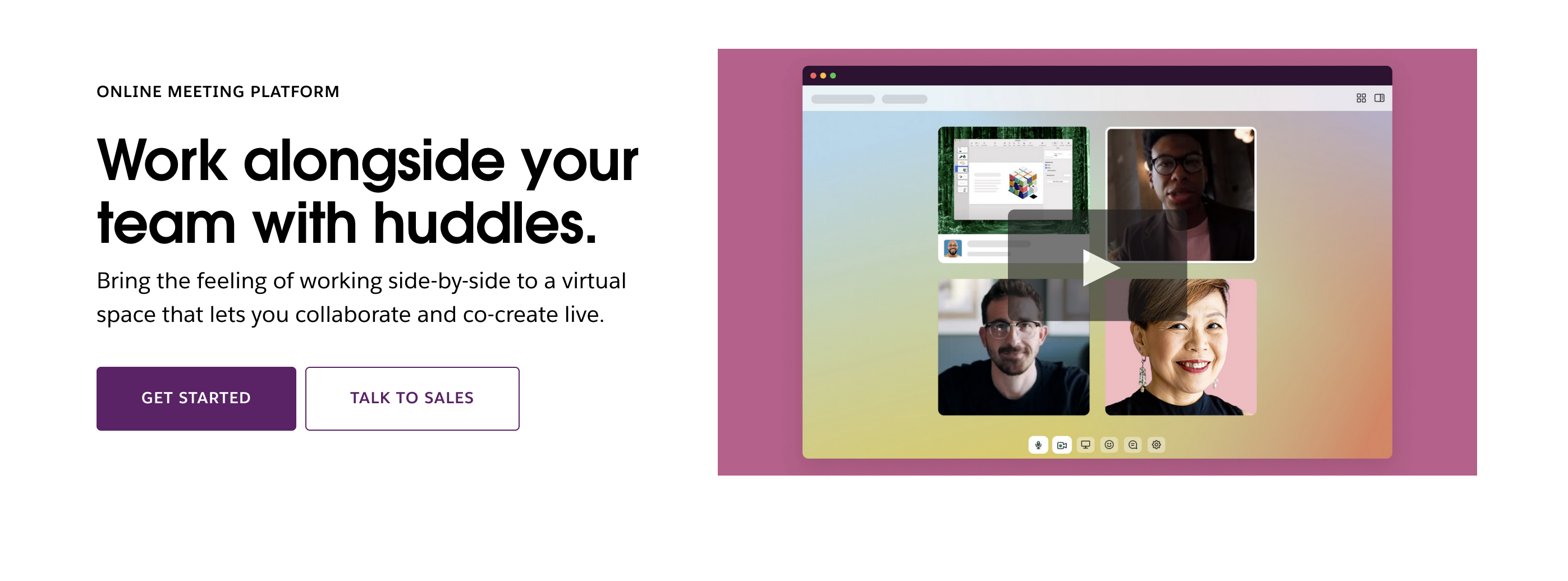
Best for: Teams already communicating in Slack channels.
Use cases: Ad hoc discussions, brainstorming, stand-ups.
Key features:
-
Instant join from any Slack thread
-
Screen sharing and emoji reactions
-
Lightweight, fast, and informal
Slack Huddles makes collaboration frictionless by bringing video directly into daily workflows.
Social Intranet Platforms
A social intranet platform is an example of collaborative technology designed to foster communication, collaboration, and information sharing within an organization. It combines elements of traditional intranets with features inspired by social media to create a digital workspace where employees can connect, share knowledge, and collaborate effectively.
Just like in your personal profile, it's important to have a good and clear profile on workplace social networks. Drawing inspiration from Facebook bio ideas can help colleagues learn interesting facts about you and build stronger connections.
Social intranet platforms play a crucial role in breaking down organizational communication barriers, promoting transparency, and creating a sense of community among employees. They are especially valuable for large and distributed teams, as they provide a virtual space for employees to connect and collaborate regardless of their physical locations.
With Workplace from Meta shutting down in May 2026, many organizations are already exploring alternatives. Here are some of the best social intranet platforms to consider for the future:
Microsoft Viva Engage
Viva Engage (formerly Yammer) is Microsoft’s social intranet solution built into Microsoft 365. It connects employees through communities, discussions, and leadership engagement tools — all integrated with Teams and SharePoint.

Best for: Enterprises using Microsoft 365 that want to enhance internal communication and culture.
Use cases: Company-wide updates, social communities, leadership Q&A, and employee recognition.
Key features:
-
Seamless integration with Teams and Outlook
-
Community-based discussions and polls
-
Analytics for engagement and sentiment tracking
Viva Engage turns internal communication into a connected, social experience that boosts belonging and transparency.
Jostle
Jostle is a people-centric intranet platform built to enhance communication, recognition, and community across organizations. It focuses on clarity — making it easy for employees to find information, connect, and celebrate wins.

Best for: Mid-sized companies that want a social, people-first intranet without heavy IT setup.
Use cases: Internal news, recognition walls, team collaboration, and community engagement.
Key features:
-
Visual org charts and community hubs
-
Recognition and celebration tools
-
Simplified admin and employee experience
Jostle helps create a vibrant internal culture where people feel seen, connected, and part of something bigger.
Staffbase
Staffbase is a leading employee communication platform and intranet designed to unify top-down announcements with bottom-up engagement. It provides branded mobile and desktop experiences ideal for distributed workforces.

Best for: Large organizations with deskless or hybrid teams that need consistent communication.
Use cases: Internal news, mobile workforce updates, HR campaigns, and CEO communications.
Key features:
-
Custom-branded intranet and mobile app
-
Segmented content targeting by role or location
-
Integration with SharePoint, Slack, and HR systems
Staffbase empowers organizations to communicate inclusively — reaching every employee, from HQ to field staff.
Simpplr
Simpplr is a modern AI-powered intranet that combines social networking, content management, and employee engagement analytics. It uses AI to surface relevant updates and personalize the employee experience.

Best for: Companies seeking a data-driven, user-friendly digital headquarters.
Use cases: Employee onboarding, knowledge sharing, culture building, and leadership communications.
Key features:
-
AI-driven content personalization
-
Built-in analytics and engagement tracking
-
Integration with Google Workspace, Salesforce, and Teams
Simpplr transforms the traditional intranet into a smart communication hub that adapts to each employee’s needs.
Haiilo
Haiilo is a social intranet platform that blends internal communication, employee advocacy, and engagement analytics. It helps employees stay informed while amplifying company messages externally.

Best for: Organizations focused on engagement, employer branding, and advocacy.
Use cases: Internal campaigns, social sharing, engagement tracking, and brand storytelling.
Key features:
-
Unified feed for company updates and discussions
-
Employee advocacy tools for LinkedIn and other platforms
-
Engagement and communication analytics
Haiilo bridges internal culture and external reputation, empowering employees to be informed ambassadors for the brand.
Project Management Software
Project management software addresses another critical aspect of collaborative technologies – organizing complex tasks efficiently among team members.
These robust collaborative technology tools help track tasks' progress, share project updates, allocate resources judiciously, and maintain timelines carefully, even when dealing with remote teams scattered across different locations.
Asana
Asana helps teams plan, organize, and track projects in real time through task lists, timelines, and workflow automation.

Best for: Teams that need flexible project tracking across departments — from marketing and product to operations.
Use cases: Campaign planning, product roadmapping, task management, and progress reporting through visual dashboards.
Key features:
-
Task lists, timelines, and Kanban boards
-
Workflow automation and templates
-
Real-time progress tracking
-
Goal and OKR alignment
-
Integrations with Slack, Teams, Google Drive, and more
Asana brings structure to cross-functional work, helping teams focus on priorities and meet deadlines without getting lost in email threads.
Trello
Trello uses a simple card-and-board system to make project tracking visual and intuitive. It’s easy to set up and perfect for smaller teams.

Best for: Startups and small teams that prefer a lightweight, visual way to organize workflows.
Use cases: Content planning, sprint tracking, onboarding workflows, and cross-functional collaboration.
Key features:
-
Drag-and-drop Kanban boards
-
Task cards with due dates, checklists, and comments
-
Automation via Butler (Trello’s AI assistant)
-
Integrations with Google Workspace, Slack, and Jira
-
Mobile apps for on-the-go task management
Trello turns complex projects into clear visual steps — helping teams stay aligned and accountable with minimal effort.
Monday.com
Monday.com combines project management, workflow automation, and analytics in one platform, offering customizable dashboards and templates.
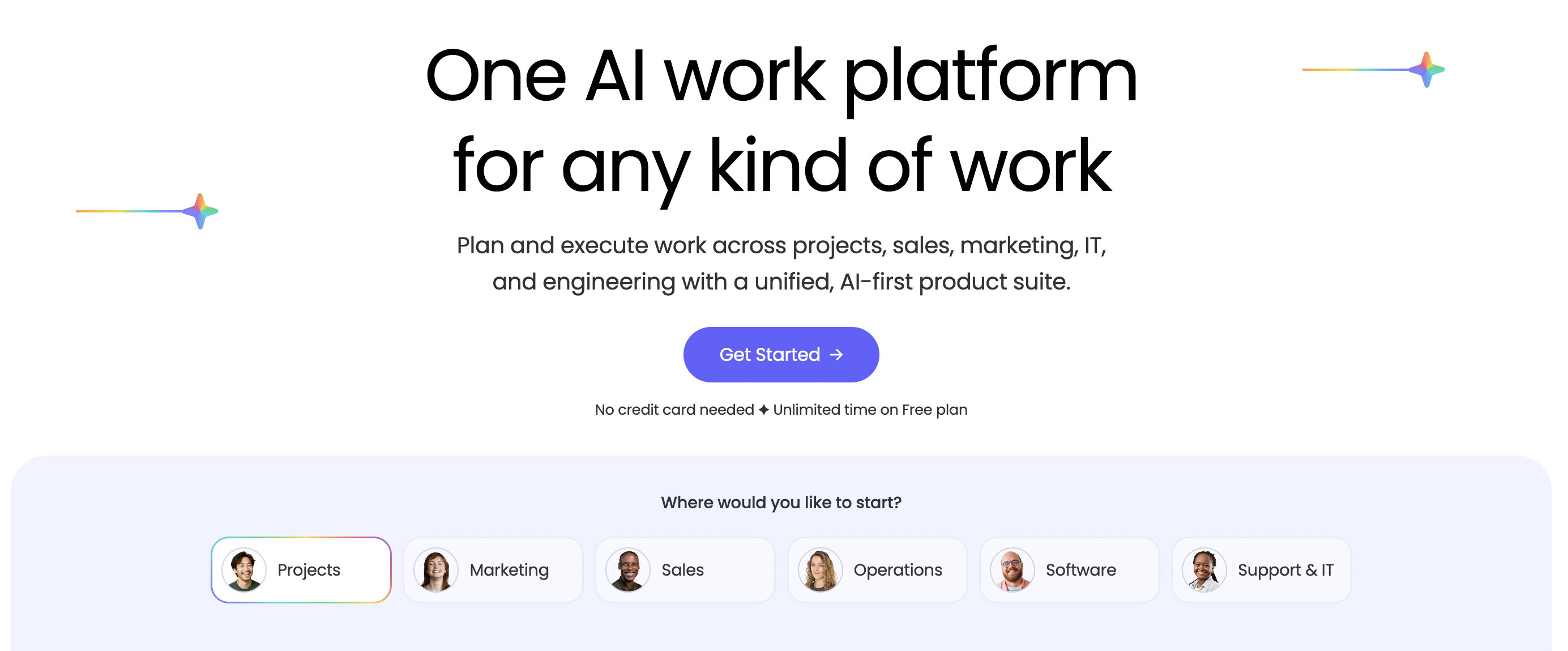
Best for: Organizations seeking a scalable all-in-one solution for managing both structured projects and daily operations.
Use cases: Cross-team coordination, goal tracking, campaign execution, and resource management.
Key features:
-
Customizable dashboards and boards
-
Workflow automation and templates
-
Built-in time tracking and reporting
-
Integrations with over 200 apps (including Slack and Teams)
-
Visual project views: Gantt, Kanban, and Calenda
Monday.com centralizes every project detail, reducing communication gaps and ensuring faster, more transparent execution.
ClickUp
ClickUp unifies tasks, documents, goals, and chat in one customizable workspace. It’s highly flexible, adapting to diverse workflows and team sizes.
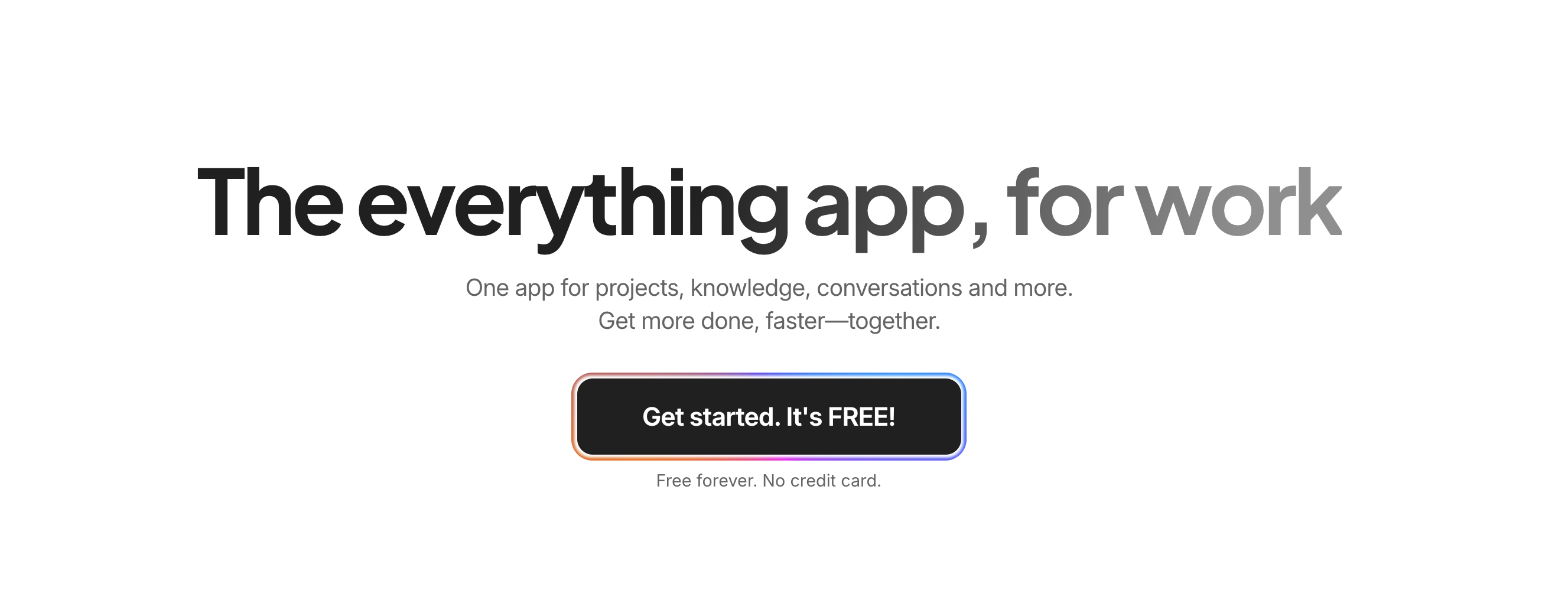
Best for: Growing teams that need powerful customization and visibility across projects.
Use cases: Agile project management, sprint planning, document collaboration, and productivity reporting.
Key features:
-
Advanced task hierarchies and dependencies
-
Time tracking and workload management
-
AI-powered writing and automation tools
-
Document collaboration and whiteboards
ClickUp eliminates tool sprawl by consolidating everything teams need to stay organized and productive in one interface.
Smartsheet
Smartsheet brings the familiarity of spreadsheets to project management, combining collaboration, automation, and enterprise-level reporting.

Best for: Enterprises managing complex, cross-departmental projects that demand structure and transparency.
Use cases: Program management, budgeting, compliance tracking, and portfolio reporting.
Key features:
-
Task and project templates
-
Conditional automation and approval workflows
-
Gantt charts and dashboards
-
Resource and budget tracking
Smartsheet bridges strategy and execution — giving teams a clear view of timelines, budgets, and outcomes in one place.
Desk and Room Booking Software
Desk and room booking software is a pivotal collaboration tool, enabling organizations to optimize their workspace utilization efficiently. These solutions allow teams to seamlessly schedule and manage shared workspaces, meeting rooms, and resources.
Desk and room booking software is vital for organizations seeking to create agile and well-utilized work environments while enhancing collaboration among team members.
YAROOMS
YAROOMS is the complete workplace management platform that unifies desk booking, room scheduling, hybrid work planning, visitor management, and workplace analytics in one intuitive system.
Key features:
-
Desk and meeting room booking via map, mobile app, or Outlook/Teams
-
Hybrid work scheduling with shared team calendars
-
Workplace analytics: occupancy, utilization, and no-show tracking
-
Service booking for catering, cleaning, and IT requests
-
Integrations with Microsoft 365, Google Workspace, Azure AD, and Slack
Best for: Mid-size to enterprise organizations managing hybrid offices or multiple global locations that rely on Microsoft 365 or need detailed workplace insights.
Use cases: Coordinating hybrid attendance, optimizing desk ratios, and managing visitor flow and room utilization.
YAROOMS helps companies right-size their offices, improve team collaboration, and make every square foot count - reducing costs while supporting flexibility.
Skedda
Skedda is a cloud-based booking platform focused on space reservation and scheduling simplicity. It’s widely used to manage desks, meeting rooms, studios, and shared spaces.

Key features:
-
Self-service booking and automated approvals
-
Interactive floor plans and color-coded space views
-
Custom booking rules and usage policies
-
Integrations with Microsoft 365, Google Workspace, and SSO providers
-
Detailed reports on utilization and demand trends
Best for: Organizations, coworking spaces, or universities seeking a lightweight but reliable space booking tool without complex setup.
Use cases: Managing hot desks, classrooms, event spaces, and meeting rooms in shared facilities.
Skedda simplifies scheduling and eliminates double bookings, freeing administrators from manual coordination.
Robin
Robin is an AI-powered workplace operations platform offering advanced desk and room scheduling, hybrid coordination, and workplace analytics.

Key features:
-
AI-driven desk and room suggestions based on preferences and teammate proximity
-
Interactive floor plans and seat assignments
-
Integrated visitor management and digital signage
-
Hybrid work coordination dashboards
-
Reporting on occupancy and meeting space usage
Best for: Mid-size to large companies that want to combine hybrid work coordination with booking automation and data analytics.
Use cases: Team-based seating plans, collaboration day planning, and visitor scheduling.
Robin brings AI into space management, helping organizations balance flexibility with efficient space utilization.
Tactic
Tactic is a hybrid workplace management software built for fast, user-friendly desk and meeting room booking. It prioritizes simplicity and employee adoption while still providing analytics for admins.

Key features:
-
One-click desk and room reservations
-
Team scheduling and office attendance visibility
-
Interactive maps and booking zones
-
Health and access check-ins for compliance tracking
-
Reporting dashboards for space usage and attendance trends
Best for: SMBs and hybrid teams that want an easy-to-adopt solution with minimal onboarding.
Use cases: Coordinating hybrid schedules, tracking office occupancy, and managing seat assignments.
Tactic keeps hybrid workplaces organized without complexity, making flexible work smoother for employees and facility teams alike.
Deskbird
Deskbird is a user-friendly hybrid work platform that lets employees easily book desks, rooms, and parking spots while syncing schedules and team availability.

Key features:
-
Desk, room, and parking booking via web or mobile app
-
Team scheduling and attendance overview
-
Outlook, Teams, and Slack integrations
-
Data dashboards for occupancy and resource efficiency
-
Mobile check-ins and access controls
Best for: Modern hybrid teams looking for a sleek, employee-first experience with strong mobile usability.
Use cases: Desk and meeting room booking, hybrid schedule planning, and real-time space visibility.
Deskbird improves coordination and space efficiency while giving employees the freedom to plan office days around collaboration and convenience.
Document Sharing Technology
Document sharing technology facilitates the seamless exchange, storage, and collaborative editing of documents within organizations. It is a cornerstone of modern business collaboration, enabling teams to collaborate efficiently, reduce the risk of version conflicts, and ensure that important documents are easily accessible when and where needed.
Google Drive
Google Drive is one of the most widely used cloud-based document sharing platforms, enabling teams to store, share, and co-edit files in real time from any device.

Key features:
-
Real-time document collaboration via Google Docs, Sheets, and Slides
-
Advanced sharing permissions and access control
-
Integration with Gmail, Google Workspace, and third-party apps
-
Offline access and version history
-
Built-in encryption and multi-factor authentication
Best for: Organizations of all sizes using Google Workspace or looking for an easy, cloud-native file collaboration solution.
Use cases: Collaborative editing, document review workflows, and centralized file storage for hybrid or remote teams.
Google Drive simplifies teamwork by letting multiple users edit, comment, and share files simultaneously — no endless email attachments needed.
Microsoft OneDrive
Microsoft OneDrive integrates deeply with Microsoft 365, providing secure cloud storage and real-time collaboration through Office apps.

Key features:
-
Seamless integration with Word, Excel, PowerPoint, and Teams
-
File versioning and auto-sync across devices
-
Enterprise-grade security with encryption and compliance controls
-
Co-authoring in Office documents
-
Offline and mobile access
Best for: Enterprises and organizations standardized on Microsoft 365 ecosystems.
Use cases: Team collaboration on Office documents, secure cloud backups, and shared storage across departments.
OneDrive ensures files stay synchronized, accessible, and compliant across distributed teams — a must for modern hybrid workplaces.
Dropbox Business
Dropbox Business combines file sharing, collaboration, and security features into one platform. It’s known for its reliability and user-friendly design.

Key features:
-
File synchronization across all devices
-
Shared folders and granular permission settings
-
Document previews and Dropbox Paper for collaboration
-
Smart sync to optimize local storage
-
Data recovery, file versioning, and admin insights
Best for: SMBs and creative teams needing simple yet powerful document sharing and storage.
Use cases: Marketing asset sharing, client file delivery, and project document version control.
Dropbox reduces friction in document workflows by centralizing file access while maintaining strong version control and data security.
Box
Box is a cloud-based content management and collaboration platform designed with enterprise security and compliance in mind.

Key features:
-
Secure document storage and sharing with advanced admin controls
-
Real-time collaboration with Microsoft 365 and Google Workspace
-
Workflow automation and approval routing
-
Compliance certifications (GDPR, HIPAA, FedRAMP, etc.)
-
AI-driven content search and document classification
Best for: Enterprises and regulated industries (healthcare, finance, government) requiring secure document collaboration and data governance.
Use cases: Contract management, compliance documentation, and cross-department content sharing.
Box allows secure, compliant collaboration across global teams, ensuring sensitive documents remain protected without limiting accessibility.
Notion
Notion goes beyond traditional document sharing — it’s an all-in-one workspace for notes, wikis, databases, and collaborative documents.

Key features:
-
Real-time co-editing and commenting
-
Page linking, templates, and custom databases
-
File embedding and document versioning
-
AI summarization and automation tools
-
Integrations with Slack, Google Drive, and GitHub
Best for: Teams that want a single collaborative hub for both structured documents and dynamic knowledge sharing.
Use cases: Knowledge base creation, internal documentation, and collaborative project planning.
Notion transforms static documents into living workspaces — improving knowledge flow, transparency, and team alignment.
Best Practices for Using Collaboration Technology
Embracing collaboration technologies can prove transformative for organizations. However, it's important to implement these tools strategically to maximize their benefits and minimize potential pitfalls. These best practices provide a strong starting point.
Set Clear Objectives and Expectations
Clear objectives and expectations are critical to encouraging the successful use of collaborative tech solutions. Every team member should completely understand what the technology can accomplish and how they're expected to utilize it for maximum advantage. This goes beyond just teaching them navigation; comprehending the purpose behind tech implementation improves acceptance, usage, and productivity.
Establish Rules for Participation
While the freedom provided by collaboration technologies is liberating and conducive to creativity, it doesn't imply an absence of a need for structure or guidelines. Indeed, establishing rules for participation ensures smoother operations within the digital workspace.
For instance:
- Define response timeframes: To avoid miscommunications or feeling neglected, a reasonable timeframe (e.g., 24 hours) may be established within which messages should be addressed.
- Encourage openness: Promote a culture where all ideas are welcomed without immediate judgment; this nurtures innovation.
- Specify offline times: To avoid burnout from constant availability driven by instant communication, establish 'quiet hours' when notifications aren't required to be responded to.
These rules cultivate respect among colleagues and foster discipline in using many features offered by collaborative technology tools without losing control.
Create a System for Resolving Conflicts
Much like traditional workplaces, conflicts could arise when using collaboration technologies due—at least partly—to misunderstandings amplified by virtual interactions. Therefore, to keep your team running at peak performance levels regardless of minor disagreements that could arise along the way, it's crucial to create an effective conflict resolution system.
How to Choose the Right Collaboration Tech for Your Business?
Choosing the right collaboration technology can seem like a daunting task due to the variety of options available in the market. But there are three fundamental aspects you need to focus on: identifying your needs, understanding your team's needs, and considering your budget.
Identify Your Needs
The first step toward selecting suitable collaborative tech tools entails identifying what prompts you to look for these technologies. Are you looking for a tool that facilitates video conferencing because that's a regular part of your business operations? Or are you seeking efficient project management software because tracking tasks has become increasingly complicated? The clearer picture you have regarding your requirements, the better equipped you'll be in choosing an apt solution.
Understand Your Team’s Needs
Understanding how your team communicates and collaborates may reveal insight into what features might help improve productivity. For instance, if teammates frequently struggle with scheduling meetings across different time zones or experience difficulty accessing shared documents outside the office, you need collaborative tech solutions offering robust calendar integration and cloud-based file-sharing capabilities.
Remember that collaboration technologies should enable seamless interactions within teams, not introduce obstacles or complications. This indicates two crucial things. Firstly, it implies that your chosen tool should fit smoothly into existing work processes rather than disrupting them. Secondly, it should be user-friendly and straightforward enough that all users can adopt it without hassle.
Consider Your Budget
Cost is a crucial factor in making any business decision. When exploring collaboration technologies examples, remember that prices can vary significantly based on factors such as the number of users, available features, and subscription plans (annualized or monthly), to name a few.
While some businesses benefit from feature-rich premium tools that tend to come with high price tags, those operating under tight constraints might find less expensive or even free versions adequate.
Remember, though, while budgetary considerations are important, you should focus on functionality; otherwise, what seems like saving now could result in inefficiency costs down the line due.
Let’s Wrap Up
In an era characterized by hybrid work models and global collaboration, it's imperative to recognize the indispensable role of collaboration technologies. These digital tools are the linchpin that bridges geographical gaps, ignites creativity and empowers real-time decision-making in the modern business landscape. They are the foundational pillars of contemporary business operations, fundamentally reshaping how we establish connections, acquire knowledge, and drive innovation in our professional endeavors.
Looking forward, the horizon is brimming with exciting possibilities as we continue to harness the transformative power of collaboration technology. Their capacity to enhance productivity, streamline operational processes, and cultivate a more interconnected and efficient work environment is bound to shape the future of work. Collaborative technologies cease to be mere tools; they emerge as the catalysts propelling us into a new era of work and collaboration.
FAQ: Workplace Collaboration Technology
What’s the Role of Collaboration Technologies in Enhancing Business Processes?
Collaboration technologies streamline how teams communicate, share information, and manage projects, leading to faster decision-making and fewer operational silos. By integrating tools for messaging, video conferencing, document sharing, and task management, organizations improve visibility, accountability, and workflow automation—enhancing both productivity and overall business performance.
What Are Some Collaborative Technology Examples?
Collaborative technology examples include video conferencing tools like Zoom and Microsoft Teams, instant messaging platforms such as Slack and Google Chat, project management software like Asana and Trello, document sharing tools such as Google Drive and Dropbox, and desk booking or workplace platforms like YAROOMS and Robin. These tools help teams communicate, coordinate, and collaborate efficiently across locations.
What Are the Latest Trends in Business Collaboration?
The latest trends in business collaboration focus on AI-powered workflows, integrated workplace platforms, and asynchronous communication that supports hybrid teams. Organizations are also adopting virtual collaboration spaces, automated meeting summaries, and data-driven insights to improve teamwork and decision-making. Together, these trends make collaboration smarter, faster, and more inclusive across distributed teams.
How Does Technology Support Collaborative Work Environments?
Technology supports collaborative work environments by connecting teams through shared digital spaces where they can communicate, plan, and create in real time. Tools like chat apps, video conferencing, and project management software enable seamless coordination, while cloud platforms ensure everyone accesses the same files and updates. This boosts transparency, speeds up decision-making, and keeps hybrid and remote teams aligned.


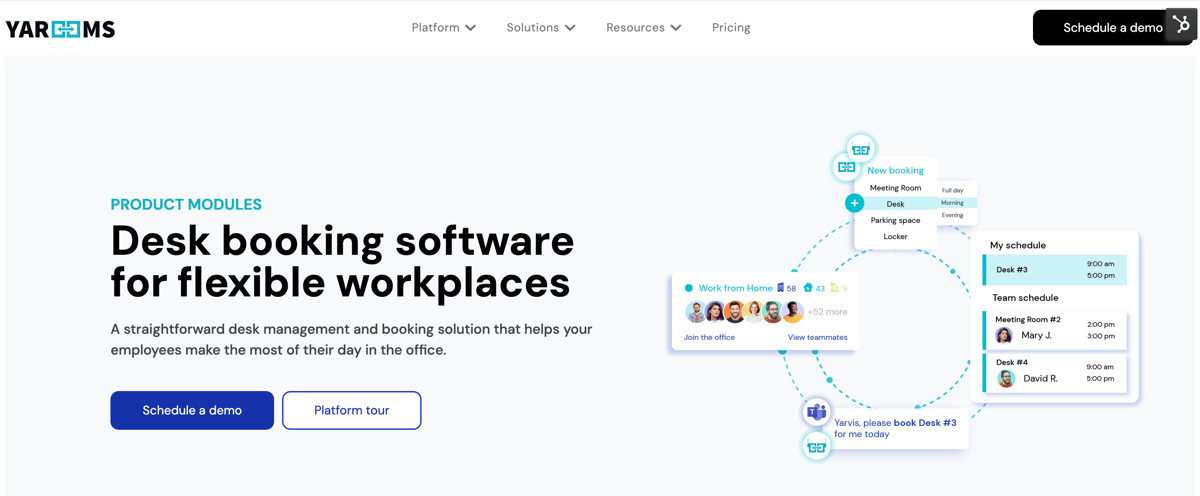
.png)









